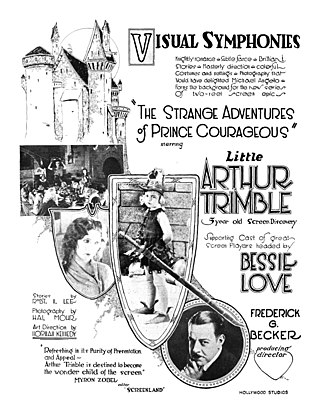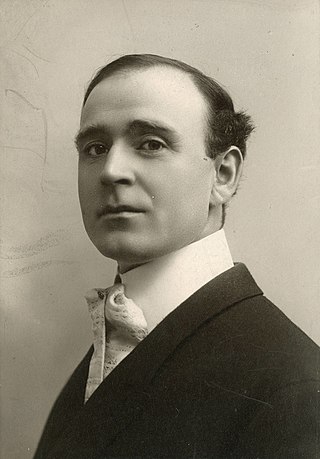
Film Booking Offices of America (FBO), registered as FBO Pictures Corp., was an American film studio of the silent era, a midsize producer and distributor of mostly low-budget films. The business began in 1918 as Robertson-Cole, an Anglo-American import-export company. Robertson-Cole began distributing films in the United States that December and opened a Los Angeles production facility in 1920. Late that year, R-C entered into a working relationship with East Coast financier Joseph P. Kennedy. A business reorganization in 1922 led to its assumption of the FBO name, first for all its distribution operations and ultimately for its own productions as well. Through Kennedy, the studio contracted with Western leading man Fred Thomson, who grew by 1925 into one of Hollywood's most popular stars. Thomson was just one of several silent screen cowboys with whom FBO became identified.

Billy West was a silent film actor, producer, and director. Active during the silent film era, he is best known as the premier Charlie Chaplin impersonator. He was a star in his own right, appearing in more than 100 films for nine different companies. Beyond acting, he also directed short comedies in the 1910s and '20s, and produced films. West retired as an actor in 1935, but remained in the employ of Columbia Pictures into the 1950s.
Rex De Rosselli, was an American actor of the silent era, mainly appearing in Westerns. He appeared in more than 150 films between 1911 and 1926. He was born in Kentucky and died in East Saint Louis. He also served as head trainer of the Universal City Zoo from approximately 1915 to 1917. Rex De Rosselli was described as a "silver-haired Beau Brummell" who alternated film work in the winters and circus work in the summers.

A 44-Calibre Mystery is a 1917 American short Western film, featuring Harry Carey. Carey plays the role of Sheriff Cheyenne Harry. He saves Kitty Flanders from Pete McGuire and takes her safely home. McGuire hides in a shack on Mr. Flanders' stake and Harry's deputy is shot dead, apparently by Mr. Flanders. McGuire offers to keep quiet about the murder if Flanders gives him half a stake and his daughter's hand in marriage. Mr. Flanders confesses his crime to Sheriff Harry and learns that he is innocent. Sheriff Harry notices McGuire's gun and accuses him of the crime, but they are killed as they try to escape. The film concludes as Kitty Flanders confesses her love to Sheriff Cheyenne as she bandages his wounds from the fight.

Betty Bouton was an American actress from Pennsylvania. She appeared in 16 films between 1919 and 1924, with her last film being the Samuel Goldwyn part-Technicolor production Cytherea (1924).

Enchantment is a 1921 American silent romantic comedy film produced by Cosmopolitan Productions and released by Paramount Pictures. The film was directed by Robert G. Vignola and starred Marion Davies. A print of the film exists in the Library of Congress.

The Strange Adventures of Prince Courageous, also known as The Adventures of Prince Courageous, is a 1923 American silent fantasy film series starring Bessie Love and five-year-old Arthur Trimble, directed by Frederick G. Becker.

Three Who Paid is a 1923 American silent Western film directed by Colin Campbell, and starring Dustin Farnum, with Bessie Love and Frank Campeau. The film was based on the 1922 short story by George Owen Baxter, and was produced and distributed through Fox Film.

Edwin L. Hollywood was an American actor and film director. He was born in New York City.

Hal Wilson, was a character actor who appeared in silent films. He was born in New York City. He was a denizen of Hollywood. He had a significant role in The Man Trap.

The Net is a 1923 American silent melodrama film directed by J. Gordon Edwards and starring Barbara Castleton, Raymond Bloomer, and Albert Roscoe. It is a film adaptation of the 1919 Broadway play of the same name, itself based on the novel The Woman's Law by Maravene Thompson. The film depicts the story of Allayne Norman (Castleton) and her husband Bruce (Bloomer). Bruce commits murder and convinces Allayne to help him blame the crime on a man suffering from amnesia (Roscoe). After Bruce dies and the man recovers, he marries Allayne.

Alfred Hollingsworth was an American actor during the silent film era. He was in dozens of films from 1911 until 1925. He also directed four short films in 1916. Hell's Hinges has been described as a classic and Hollingsworth earned plaudits for his role in it.

Ramsey Wallace (1883-1933) was an actor in silent films. His work included leading roles. He starred in A Voice in the Dark. He received a favorable review for his leading role in The Call of Home.

Frederick Harmon Weight was an American film director most prolific in the late silent film era of the 1920s. He directed many well-known performers such as George Arliss, Betty Compson, Myrna Loy and Rin-Tin-Tin.

Hapsburg Liebe, born Charles Haven Liebe, (1880-1957) was an American author and screenwriter. His stories were published in Adventure, The Black Cat, The Railroad Trainman, The Green Book Magazine, Boys' Life and Florida Wildlife.

Thomas Carrigan was an actor who starred in silent films in the U.S. He appeared in early Selig films and played dime store novel detective character Nick Carter in a series of short films.

William Robert Daly was an actor and director of silent films in the U.S.
Sir William Frederick Jury was an influential film businessman in Britain. He led Jury Imperial Pictures, a British film production company during the silent film era. The company was a leading renter of films and contracted to distribute official British films. It was also a distributor of American films and was active in British colonies. Jury was also involved in distributing propaganda films for the British government. In 1914, he corresponded with William N. Selig.
The Fearless Lover is a lost 1925 American silent drama film directed by Scott R. Dunlap and Henry MacRae and starring William Fairbanks, Eva Novak, and Tom Kennedy.
Gayety Comedies are a comedy film series released made in the United States during the silent film era. They debuted in 1919 and were distributed to various film exchanges Al Christie produced them. The studio that made them was owned by E. H. Emmick and J. L. Friedman and was on the corner of Sunset Boulevard and Gower Street.

















